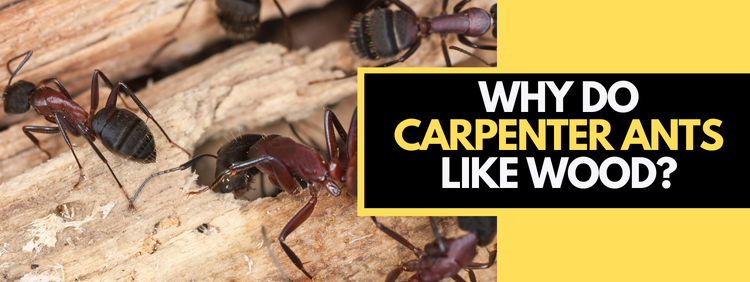Why Do Carpenter Ants Like Wood?

Carpenter ants get their name from the fact that they make nests in wood. Carpenter ant pest control is necessary when you have an infestation in your house to prevent further damage. Therefore, it is important to be alert to the signs of possible infestation. It also helps to understand what draws carpenter ants to wood in the first place.
Why Do Carpenter Ants Like Wood?
Many species of animals need a safe place in which they can raise their offspring. Carpenter ants make nests in wood by digging tunnels where the queen can then lay her eggs and the workers can take care of the larvae once they hatch. Since wood is a hard, sturdy substance, it provides a degree of protection not only to the vulnerable eggs and larvae but to the entire ant colony.
In the wild, carpenter ants often build their nests in fallen logs or old stumps. This is actually beneficial because it helps dead wood to decompose more quickly, which replenishes nutrients in the soil. However, an infestation of your house requires carpenter ant removal to prevent structural damage.
Do Carpenter Ants Eat Wood?
Carpenter ants are often confused with termites. Both types of insects can cause extensive damage to wooden structures and require residential pest control to get rid of. The most important difference between the two is that termites actually eat wood, but carpenter ants don’t.
Carpenter ants excavate tunnels in wood to build their nests. They start with one tunnel, and from there, they keep branching off. As the colony keeps growing, the ants need more room and keep making the nest bigger and bigger by digging more tunnels. Eventually, they can hollow out even a large piece of wood, such as a support beam.
The only tools that carpenter ants have to excavate wood are their strong mandibles or jaws. If you could observe their work, it might appear that they were eating the wood, but really they just chew it up.
Why Do Carpenter Ants Like Moist Wood?
While carpenter ants can chew into any type of wood, they do prefer it if the material is moist. Wood that has absorbed water is soft and easier for the ants to chew through. Second, the eggs need moisture in order to grow and mature. If the humidity in the environment was too low, the eggs would dry out.
What Are Some Signs of a Carpenter Ant Infestation?
Being alert to signs of a carpenter ant infestation can help you prevent extensive damage to your home. One of the first signs you may notice is frass. This refers to the remains of the wood that ants have chewed up to make their tunnels. Frass looks like fine sawdust, and you may find little piles of it around your home. As the carpenter ants excavate tunnels, they push out the frass behind them. If you look above where the frass is collecting, you may see a tiny hole which is the entrance to the tunnel. However, these holes can be hard to spot because of their size.
Sometimes, when the house is quiet, you can hear the sound of carpenter ants moving around in their nests. This sounds like a rustling, and it is usually only perceivable when the colony has grown large. If you hear it, you should take action right away.
Another sign of an infestation is if you keep seeing carpenter ants around your home. Carpenter ants are pretty recognizable because of their large size. They are usually black but can also be red or a combination of red and black.
Call Truly Nolen at the first sign of carpenter ant infestation for residential pest control. We can assess your property, locate the main nest and any satellite colonies, and determine a plan of action customized to your needs.